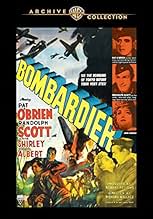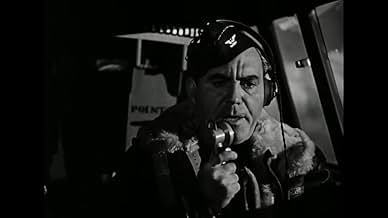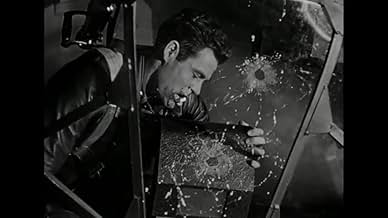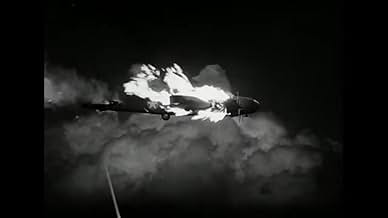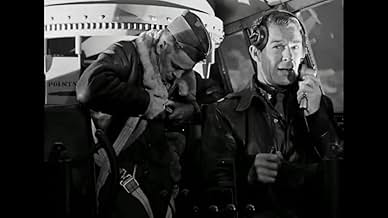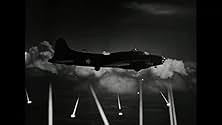O Major Davis está convencido de que os bombardeios de alto nível vencerão a próxima guerra. Ele convence os poderes de estabelecer uma escola de bombardeiros e treina a primeira geração de ... Ler tudoO Major Davis está convencido de que os bombardeios de alto nível vencerão a próxima guerra. Ele convence os poderes de estabelecer uma escola de bombardeiros e treina a primeira geração de bombardeiros de alto nível da USAAF.O Major Davis está convencido de que os bombardeios de alto nível vencerão a próxima guerra. Ele convence os poderes de estabelecer uma escola de bombardeiros e treina a primeira geração de bombardeiros de alto nível da USAAF.
- Direção
- Roteiristas
- Artistas
- Indicado a 1 Oscar
- 1 vitória e 1 indicação no total
Eugene L. Eubank
- General Eubank
- (as Brigadier-General Eugene L. Eubank)
Murray Alper
- Little Boy - Spy
- (não creditado)
Stanley Andrews
- Congressman
- (não creditado)
Joan Barclay
- Buck's Secretary
- (não creditado)
Hugh Beaumont
- Soldier
- (não creditado)
Avaliações em destaque
I saw this movie in the late 1950's or early 1960's on TV and it has always stuck with me. The scene that stands out vividly is when Robert Ryan walks into the church and yells, "The Japs just bombed Pearl Harbor". That scene has stuck in my head over 50 years. Oddly it seems that the ending involves bombing Nagoya. The movie went from Japanese bombing Pearl Harbor to the U.S. bombing the Japanese homeland really quickly. Another interesting thing is the movie never uses the word Norton Bombsight. At the time of the movie, even the word Norton was secret. Also, you never see the actual bomb sight only something being carried in a cloth bag by two airmen. Even a picture of the sight was secret. I did like the picture because it shows the training the men received. It seems like a lot of training just to push a button. I also like of part of the Bombardier controlling the plane. The part of the movie seems right in that the plane, pilot, ground crew, and everything else is there just to take the Bombardier to the target so he can push a button. The Pilot and Bombardier is like playing golf. The drive is for the show (pilot) but the putt (bombardier) is for the dough!. The rest was over the top--the oath and song of the Bombardier. Lastly, wasn't the actor who played the Japanese officer also played "Harry Hoo" on the TV show "Get Smart". All in all a film worth watching.
This is a typical Hollywood movie made to contribute to the war effort during WWII, using all available means, in this case, cinema. It's a blend of war propaganda to raise awareness of the country's war effort and promote the sale of war bonds, while also serving as a call for new recruits.
For fans of WWII war films, especially those set in the world of aviation, it's undoubtedly an interesting movie. It showcases the training required to become a bombardier, with a focus on precision bombing training, a perspective rarely seen before and not replicated in later films. It can provide a complementary view for fans of the celebrated "12 O'Clock High" series, which omits this training aspect in its production.
The narrative is straightforward and linear, with the actors delivering decent performances without any particular standout.
As always, it's intriguing to watch a movie made during the same period as the events it portrays, as it usually features accurate uniforms and vehicles. However, in this case, it's worth noting that the final mission over Nagoya, depicted in the film, couldn't have been carried out by the B-17 bombers shown because it was beyond the reach of Allied bases in the Pacific. This aspect detracts from the film's credibility in portraying the events. In reality, these planes were later deployed in the Mediterranean theater, where they were used extensively.
One surprising aspect of the film is the clear portrayal of the effort to conceal the Norden bomb sight, a targeting system. In reality, the crews were instructed to destroy it in case of bailout. Yet, the film shows it, which might have been seen by enemies. However, the film doesn't reveal the exact workings of the system, so it might have served as a warning to demoralize the enemy. Lastly, when the pilot orders the crew to bail out due to a control failure, in reality, the manual procedure included attempting to restart the engines as a last resort, something not depicted in the film but done by a crew member who chose not to bail out.
Overall, it's a fairly decent movie with good shots for its time, although it doesn't particularly stand out in terms of cinematic quality.
For fans of WWII war films, especially those set in the world of aviation, it's undoubtedly an interesting movie. It showcases the training required to become a bombardier, with a focus on precision bombing training, a perspective rarely seen before and not replicated in later films. It can provide a complementary view for fans of the celebrated "12 O'Clock High" series, which omits this training aspect in its production.
The narrative is straightforward and linear, with the actors delivering decent performances without any particular standout.
As always, it's intriguing to watch a movie made during the same period as the events it portrays, as it usually features accurate uniforms and vehicles. However, in this case, it's worth noting that the final mission over Nagoya, depicted in the film, couldn't have been carried out by the B-17 bombers shown because it was beyond the reach of Allied bases in the Pacific. This aspect detracts from the film's credibility in portraying the events. In reality, these planes were later deployed in the Mediterranean theater, where they were used extensively.
One surprising aspect of the film is the clear portrayal of the effort to conceal the Norden bomb sight, a targeting system. In reality, the crews were instructed to destroy it in case of bailout. Yet, the film shows it, which might have been seen by enemies. However, the film doesn't reveal the exact workings of the system, so it might have served as a warning to demoralize the enemy. Lastly, when the pilot orders the crew to bail out due to a control failure, in reality, the manual procedure included attempting to restart the engines as a last resort, something not depicted in the film but done by a crew member who chose not to bail out.
Overall, it's a fairly decent movie with good shots for its time, although it doesn't particularly stand out in terms of cinematic quality.
Pat O'Brien takes his Knute Rockne character and joins the Army Air Corps in Bombardier and he and Randolph Scott have a disagreement as far as air tactics go. Scott wants to do things as they do in the RAF where he's been an observer. Fly in low and drop bombs and avoid being shot at.
O'Brien is more interested in technology. Develop and learn how to use an accurate bombsight so you can be up around 20,000 feet and only have to worry about enemy planes which presumably your fighter escort has to deal with.
But since these guys are friends it's a good natured fight as both are in the business of training bombardiers. Among the familiar faces they train are Eddie Albert and Robert Ryan before both went in the service themselves.
Bombardier is so very dated now, but still entertaining. The advances in technology are light years beyond what O'Brien and Scott are dealing with. Film buffs who are air historians might like it though.
O'Brien is more interested in technology. Develop and learn how to use an accurate bombsight so you can be up around 20,000 feet and only have to worry about enemy planes which presumably your fighter escort has to deal with.
But since these guys are friends it's a good natured fight as both are in the business of training bombardiers. Among the familiar faces they train are Eddie Albert and Robert Ryan before both went in the service themselves.
Bombardier is so very dated now, but still entertaining. The advances in technology are light years beyond what O'Brien and Scott are dealing with. Film buffs who are air historians might like it though.
Major "Chick" Davis (Pat O'Brien) argues for precision high altitude bombing rather than dive bombers. He wins in a bombing competition. It's the start of a new bombardier training program and then America is forced into the war.
There is no way that the bombers are that accurate. Those bullseye targets are impossible until laser-guided bombs. In fact, something as big as a tank would be hard to hit by any plane of that era. Of course, this is wartime propaganda and it serves its purpose. There is some miniature work along with the use of the real bombers. For its time, some of it actually looks good. The story is done in a straight, patriotic, and old fashion melodramatic way. There are a couple of familiar faces. It gets rather intense when some of them get captured which culminates in a bombastic patriotic flourish.
There is no way that the bombers are that accurate. Those bullseye targets are impossible until laser-guided bombs. In fact, something as big as a tank would be hard to hit by any plane of that era. Of course, this is wartime propaganda and it serves its purpose. There is some miniature work along with the use of the real bombers. For its time, some of it actually looks good. The story is done in a straight, patriotic, and old fashion melodramatic way. There are a couple of familiar faces. It gets rather intense when some of them get captured which culminates in a bombastic patriotic flourish.
There were a lot of films made by Hollywood during the war years that were designed to drum up support for our troops from the public. Seen today, some might dismiss them or just see them as propaganda--which they technically are, but of a positive sort and meant to unify the nation. This film is a pretty effective and entertaining example of the genre--having a pretty realistic script and good production values. Pat O'Brien plays pretty much the same character he played in MANY other films (you know, the tough-talking, hard-driven but "swell guy"). Randolph Scott is, as always, competent and entertaining and the rest of the extras are excellent (look for a young Robert Ryan as one of the bombardiers in training). While the story is reminiscent of several other movies about our pilots and crews, the film is well-crafted enough to make it interesting and not too far-fetched. That it, perhaps, except for the very end--where the film is a bit over-the-top but also VERY satisfying. About the only serious negative, and this is mostly for nitpickers, is that some of the stock footage is somewhat sloppily integrated in the film and "nuts" like me who are both history teachers and airplane lovers will probably notice this--all others probably won't notice.
Você sabia?
- CuriosidadesThe American bomb sight mentioned throughout the movie was the Norden bomb sight whose secret was almost as closely guarded as the development of the atomic bomb. It used a mechanical computer and linkage to the plane's autopilot to achieve an accuracy of hitting with 75 feet of the target from an altitude of 12000 feet. All members of the bomber's crew were ordered to destroy the sight at all costs if the plane was going to crash. Many ships carried a hand grenade to place under the sight to assure total destruction. It was used as late as 1967 to drop sensors along the Ho Chi Minh trail in Viet Nam.
- Erros de gravaçãoThe Douglas B18's, Beechcraft AT11's and B17 aircraft all sport national markings found from May 1942 until June 1943, yet a considerable part of this film takes place before Pearl Harbor.
- Citações
Burton Hughes: You're quite an entomologist.
Sgt. Archie Dixon: Nope! But I know all about bugs.
- Cenas durante ou pós-créditosBrigadier General Eugene L. Eubank is billed first because he is credited in the forward before any cast is mentioned, and he is not listed in the comprehensive end credits.
- Versões alternativasAlso available in a computer colorized version.
- ConexõesReferences Adeus, Mr. Chips (1939)
- Trilhas sonorasSong of the Bombardiers
(1942) (published title)
On-screen title: "Song of the U. S. Bombardiers"
Music by M.K. Jerome (as M. K. Jerome)
Lyrics by Jack Scholl
Played during the opening and closing credits and often in the score
Sung by the audience at the magic show
Principais escolhas
Faça login para avaliar e ver a lista de recomendações personalizadas
Detalhes
- Tempo de duração
- 1 h 39 min(99 min)
- Cor
- Proporção
- 1.37 : 1
Contribua para esta página
Sugerir uma alteração ou adicionar conteúdo ausente


